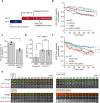The Mis6 inner kinetochore subcomplex maintains CENP-A nucleosomes against centromeric non-coding transcription during mitosis
- PMID: 35970865
- PMCID: PMC9378642
- DOI: 10.1038/s42003-022-03786-y
The Mis6 inner kinetochore subcomplex maintains CENP-A nucleosomes against centromeric non-coding transcription during mitosis
Abstract
Centromeres are established by nucleosomes containing the histone H3 variant CENP-A. CENP-A is recruited to centromeres by the Mis18-HJURP machinery. During mitosis, CENP-A recruitment ceases, implying the necessity of CENP-A maintenance at centromeres, although the exact underlying mechanism remains elusive. Herein, we show that the inner kinetochore protein Mis6 (CENP-I) and Mis15 (CENP-N) retain CENP-A during mitosis in fission yeast. Eliminating Mis6 or Mis15 during mitosis caused immediate loss of pre-existing CENP-A at centromeres. CENP-A loss occurred due to the transcriptional upregulation of non-coding RNAs at the central core region of centromeres, as confirmed by the observation RNA polymerase II inhibition preventing CENP-A loss from centromeres in the mis6 mutant. Thus, we concluded that the inner kinetochore complex containing Mis6-Mis15 blocks the indiscriminate transcription of non-coding RNAs at the core centromere, thereby retaining the epigenetic inheritance of CENP-A during mitosis.
© 2022. The Author(s).
Conflict of interest statement
The authors declare no competing interests.
Figures





Similar articles
-
Eic1 links Mis18 with the CCAN/Mis6/Ctf19 complex to promote CENP-A assembly.Open Biol. 2014 Apr 30;4(4):140043. doi: 10.1098/rsob.140043. Open Biol. 2014. PMID: 24789708 Free PMC article.
-
Mis16 and Mis18 are required for CENP-A loading and histone deacetylation at centromeres.Cell. 2004 Sep 17;118(6):715-29. doi: 10.1016/j.cell.2004.09.002. Cell. 2004. PMID: 15369671
-
Kinetochore Components Required for Centromeric Chromatin Assembly Are Impacted by Msc1 in Schizosaccharomyces pombe.Genetics. 2017 Oct;207(2):559-569. doi: 10.1534/genetics.117.300183. Epub 2017 Aug 21. Genetics. 2017. PMID: 28827290 Free PMC article.
-
Putting CENP-A in its place.Cell Mol Life Sci. 2013 Feb;70(3):387-406. doi: 10.1007/s00018-012-1048-8. Epub 2012 Jun 23. Cell Mol Life Sci. 2013. PMID: 22729156 Free PMC article. Review.
-
Does a GATA factor make the bed for centromeric nucleosomes?Cell Cycle. 2003 Jul-Aug;2(4):277-8. Cell Cycle. 2003. PMID: 12851470 Review.
References
Publication types
MeSH terms
Substances
LinkOut - more resources
Full Text Sources
Molecular Biology Databases
Research Materials

